Interactive activities bring positive motivation and enhance the
learning process, the impact being highly beneficial, with
motivational, cognitive and affective values. Students learn easily
by ‘playing’.
Interactive Activities in the English Class
Învăţământ gimnazial | Limbi moderne
Propus de: devibad | 09.06.2016 23:41 | Revista cadrelor didactice nr. 30/2016 | 3028 vizualizări
Modern education relies on interactive teaching and learning that focus on the student’s needs and reflect the new socio-cultural and educational trends in general. For the English teacher, games are just a pretext, an educational context used to build and develop skills whereas children gain important acquisitions for their adult life. Interactive activities offer opportunities to use the language structures repeatedly and to build a habit from the structures provided. Overall, they encourage students to become autonomous in their own learning process. In terms of what skills need to be taught and how to be done, teaching skills in isolation is outdated and does not meet the requirements of today’s world: communicative competences, which means using the four language skills of speaking, reading, listening and writing to communicate a message in a given context. Teaching the four skills in a restraint-free class serves many valuable purposes, from offering the required support to the language learners, to providing the context in which to use the language for exchanges of real information, and boosting students’ self-confidence.
Therefore, I have chosen to discuss 5 student-centered activities especially designed to incorporate several language skills simultaneously which have worked well in my classes. They fit beginner to intermediate levels and help develop skills and language competences.
I. FIND SOMEBODY WHO…
Language: learning names, getting to know each-other, revising grammatical structures, asking and answering questions
Level: elementary to intermediate
Timing: 15 minutes
Materials: handouts / cards with missing information
Procedure:
1. Give students the handouts or the cards. Example sentences:
Find somebody who… likes milk / hates fast food.
Find somebody who… watched the news yesterday evening.
Find somebody who… has been to another country.
Find somebody who… will spend his/her summer holidays abroad.
2. Students walk around the classroom and exchange information with their classmates, finding people who meet to the requirements set out. They cannot write the same student twice. Students mingle, exchange information and complete their cards.
3. The first 3-5 to finish completing their cards are the winners. They report their findings to the rest of the class who can confirm the information presented is correct. Red points, stickers or small prizes can be awarded for increased motivation.
II. BOARD RELAY BRAINSTORM
Language: increasing students confidence, building vocabulary
Level: beginner to intermediate
Timing: 5 minutes
Materials: markers / flipchart/ chalk of different color
Preparation: -
Procedure:
1. Students work in teams. For this game, I usually form the teams with the students seated in the same rows, which means I have either 3 or 4 teams. The first student in each row gets a marker of a different color and goes out to the board.
2. Call the lexical group (E.g. jobs, food, feelings, body parts, clothes, compounds, uncountable nouns, adverbs, gerunds, etc). Students start writing on the board as many words as they can until you shout ‘Switch!’ Now, they run back to their place, hand the marker/ chalk over to the next student who then races to the board and continues the list.
3. Students write new words each time and correct the mistakes, if they see any. Therefore, while waiting for their turn, they must check on their peers’ spelling. Repeated words will be erased.
4. The procedure can be repeated until all students have had a chance to add new words to the list. The winner is the team with most correct words.
III. ERROR-TEXT
Language: listening for specific details
Level: beginner to intermediate
Timing: 15 minutes
Materials: any short text
Preparation: -
Procedure:
1. Read the text. Tell students they can write down any 5 key words from the text.
2. Get the students work in pairs and use the 5 key words to re-tell the story.
3. Ask a few pairs to tell their story to the class.
4. Put students in two teams. Re-read the text and deliberately make several mistakes. Students shout “STOP” to correct the teacher, scoring one point for each correct answer.
5. If they are able to spot mistake but not able to correct it, offer the possibility to the opposing team.
IV. JIGSAW – RUNNING DICTATION
Language: sequencing pieces of a jumbled text, first skimming for meaning, then scanning for detail
Level: elementary to intermediate
Timing: 30 minutes
Materials: a short text, envelopes / balloons
Preparation: Print the text and cut it into pieces containing one or two shorter sentences. Stick the slips all around the classroom (on the walls, windows, door, board, etc.) face up / down.
Procedure:
1. Tell students they are going to reconstruct a text that has been jumbled and scattered all around the classroom.
2. Form groups and tell students that one student from each group has to go out, read and memorize one sentence, then go back to the group and dictate it. If students forget words, they can go back to the wall and re-read the text. Everybody in the group must write the sentences in their copybooks. Tell students to pay attention to punctuation marks, as well.
3. When the first student in each group finishes dictating, a second one goes out and reads a second sentence, memorizes and dictates it. The procedure is repeated in the same way until all students have been out.
4. If there still are slips displayed, the cycle is repeated starting with the first student.
5. When they finished dictating and writing all the sentences, students read the sentences and put them in the correct order.
6. Ask the groups to tell you when they are ready, so you can check that their order is correct. The first group to finish with a correct order is the winner.
7. Follow-up: answer questions about the text.
Variation 1
Cut the text into pieces as above and place the pieces in an envelope, one for each group. Ask the students to read each of the pieces and place them in the correct sequence. The first group to finish with a correct sequence is the winner.
Variation 2
Cut two texts into pieces, roll and insert them inside a balloon, one for each group. Print the texts on different color paper for each group so that the pieces do not mix with those of other groups in the process of bursting balloons: students pop them in order to get the pieces out. (Add whatever rule you wish here: no sharp objects are allowed, pop the balloons by sitting / stepping on them or by pressing them back-to-back, etc.) Ask students to decide where each piece belongs to and then put the two texts in the correct order. The first group to finish with a correct sequence is the winner.
Variation 3
Use a word processor to write a short text in big letters. Write one sentence per page. You need as many sentences as there are students in the class. Give one sentence to each student. Ask them to stand up, mingle and read the sentences of their classmates. Set a time limit of 3 minutes. Now they have to arrange themselves in a circle /line according to the sequence in which they think their sentences appear. When they are done, ask them to read their sentences aloud. For feed-back, play the tape or read the original text yourself.
V. DOING THE LAUNDRY
Language: making sentences using adverbs of frequency, paying attention to word order
Level: beginner to elementary
Time: 50 minutes
Materials: word cards, string, clothes pegs / Lego pieces (optional)
Preparation: Write different parts of speech on different color paper. Prepare a bag with several colored word cards for each group. Add a piece of string and some clothes pegs.
Procedure:
1. Divide the students in groups. Explain that they are going to collaborate in order to make sentences, using frequency adverbs and paying attention to word order.
2. Distribute the bags. Tell students to arrange the word cards in various ways to create correct sentences. Each sentence should contain frequency adverbs.
3. Each time they create a sentence, two students hold the string while the others hang the cards on the string, using clothes pegs.
4. For each correct sentence, groups get a star. The group with most stars is the winner.
Variation – LEGO SENTENCE
Lego pieces can be used instead of word cards. You need pieces of different color / size to stand for different parts of speech or of a sentence: subject (long, green), predicate (long, orange), adverb (medium, pink), auxiliary verbs (medium, orange), negation (medium, blue), other words (small, yellow). Give each group a bag with enough Lego pieces and a handout with jumbled sentences. Do the first sentence together to demonstrate how the game works.
e.g. for/am/late/I/school/never/ = green - pink - blue - long orange – yellow = I am never late for school.
Next, ask groups to arrange the pieces on their desks for the each sentence and invite them to read it aloud. e.g. your/cook/in/mother/does/evening/the/always = medium orange - green - pink - long orange - yellow. = Does your mother always cook in the evening?
Profesor Șandru Gabriela
Școala Gimnazială „Tudor Vladimirescu” Tg.-Mureș


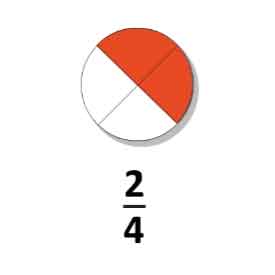



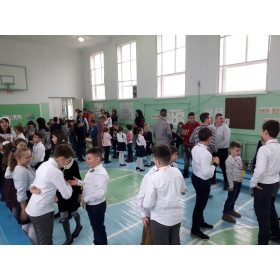
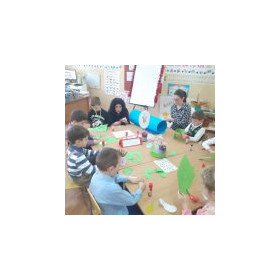



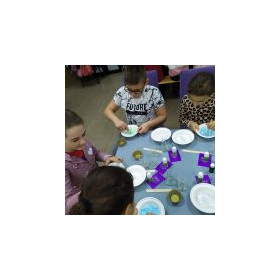
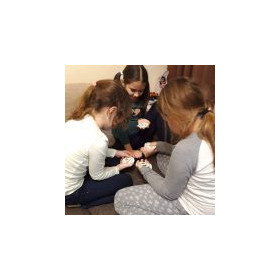
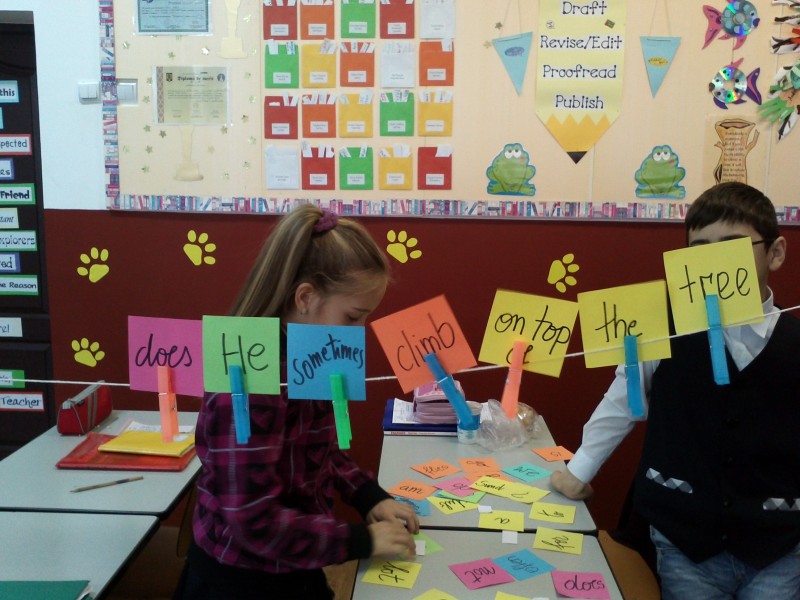






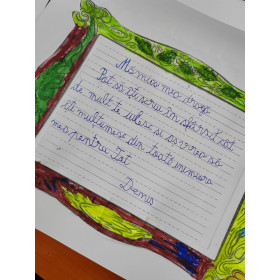



Comentarii (0)
Nu există niciun comentariu
Autentificaţi-vă pe site pentru a putea publica un comentariu.